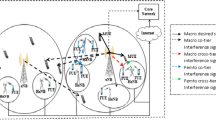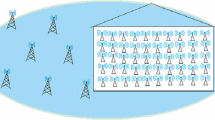Abstract
Femtocell deployment is an important strategy when it comes to improvement of QoS metrics in areas of poor cell coverage like indoors in an LTE environment. This, however, is accompanied by bottlenecks in resource allocation and trade-offs in accuracy for interference management in the heterogeneous two-tier network of macro and femtocell environment. To that end, we propose two schemes using radial division of cells that allocate sub-bands to both femtocell users and macrocell users which in turn, mitigates co-channel interference. Simulation results show that our proposed schemes, commonly named as radial sub-band allocation (RSA-1 and RSA-2) improve performance as measured by signal to interference and noise ratio, sum throughput, outage probability, and channel reuse efficiency while maintaining a balance in computational complexity with existing schemes like F-ALOHA. Further experimentation revealed that the proposed version also works exceedingly well in ultra-dense environments.









Similar content being viewed by others
References
Jo, H.-S., Xia, P., & Andrews, J. G. (2012). Open, closed, and shared access femtocells in the downlink. EURASIP Journal on Wireless Communications and Networking, 2012(1), 363.
Binglai, N., & Wong, V. W. S. (2016). Network configuration for two-tier macro–femto systems with hybrid access. IEEE Transactions on Vehicular Technology, 65(4), 2528–2543.
Dikmese, S., et al. (2014). Spectrum sensing and resource allocation models for enhanced OFDM based cognitive radio. In 2014 9th international conference on cognitive radio oriented wireless networks and communications (CROWNCOM IEEE).
Oh, D.-C., Lee, H.-C., & Lee, Y.-H. (2010). Cognitive radio based femtocell resource allocation. In 2010 international conference on information and communication technology convergence (ICTC). Washington: IEEE.
Hwang, D., et al. (2017). Resource allocation based on channel sensing and spatial spectrum reuse for cognitive femtocells. Wireless Personal Communications, 97(2), 2249–2268.
Shi, L., & Yoo, S.-J. (2017). Distributed fair resource allocation for cognitive femtocell networks. Wireless Personal Communications, 93(4), 883-–902.
Awoyemi, B. S., Bodhaswar, T. J. M., & Alfa, A. S. (2016). Solving resource allocation problems in cognitive radio networks: A survey. EURASIP Journal on Wireless Communications and Networking, 2016(1), 176.
Lee, P., Lee, T., Jeong, J., & Shin, J. (2010). Interference management in LTE femtocell systems using fractional frequency reuse. In 2010 The 12th international conference on advanced communication technology (ICACT) (Vol. 2, pp. 1047–1051).
Järvinen, M., & Hämäläinen, P. J. (2009). Femtocell deployment in 3rd generation networks. Finland: Master’s Thesis of Helsinki University of Technology.
Cao, G., Yang, D., An, R., Ye, X., Zheng, R., & Zhang, X. (2011). An adaptive sub-band allocation scheme for dense femtocell environment (pp. 102–107). Washington: IEEE.
Fu, I.-K., Chou, K., Chen, Y.-S., & Cheng, P. (2008). Adaptive frequency reuse for interference management in IEEE 802.16m system.
Lee, C., Huang, J. H., & Wang, L. C. (2010). Distributed channel selection principles for femtocells with two-tier interference. In 2010 IEEE 71st vehicular technology conference (pp. 1–5).
Li, W., Chen, J., Long, H., & Wu, B. (2012). Performance and analysis on LTE system under adjacent channel interference of broadcasting system. In 2012 IEEE 12th international conference on computer and information technology (pp. 290–294).
Lu, Y., Song, S. H., & Letaief, K. B. (2016). Optimal overlay cognitive spectrum access with F-ALOHA in macro–femto heterogeneous networks. IEEE Transactions on Wireless Communications, 15(2), 1323–1335.
Nikitin, A. V., Davidchack, R. L., & Smith, J. E. (2015). Out-of-band and adjacent-channel interference reduction by analog nonlinear filters. EURASIP Journal on Advances in Signal Processing, 2015(1), 12.
Aguilar-Garcia, A., Fortes, S., Molina-Garcìa, M., Calle-Sànchez, J., Alonso, J. I., Garrido, A., et al. (2015). Location-aware self-organizing methods in femtocell networks. Computer Networks, 93, 125–140.
Cazals, F., & Karande, C. (2008). A note on the problem of reporting maximal cliques. Theoretical Computer Science, 407(1), 564–568.
Wildman, J. (2011). Bron–Kerbosch maximal clique finding algorithm—File exchange. Natick: MATLAB Central.
Bron, C., & Kerbosch, J. (1973). Algorithm 457: Finding all cliques of an undirected graph. Communication of ACM, 16(9), 575–577.
D’Errico, J. (2018). http://bit.ly/ILPAmatlab. Accessed 15 Jan 2018.
Okamoto, H., Kitao, K., & Ichitsubo, S. (2009). Outdoor-to-indoor propagation loss prediction in 800-MHz to 8-GHz band for an urban area. IEEE Transactions on Vehicular Technology, 58(3), 1059–1067.
Figueiredo, D., Matos, P., Cota, N., & Rodrigues, A. (2006). Adjacent channel interference, pp. 186–192.
http://www.telecomabc.com/a/acir.html. Accessed 15 Jan 2018.
Goldsmith, A. J., & Chua, S.-G. (1997). Variable-rate variable-power MQAM for fading channels. IEEE Transactions on Communications, 45(10), 1218–1230.
Osseiran, A., Doppler, K., Ribeiro, C., Xiao, M., Skoglund, M., & Manssour, J. (2009). Advances in device-to-device communications and network coding for IMT-advanced.
Pradhan, A., Basu, S., Sarkar, S., Mitra, S., & Roy, S. D. (2018). Implementation of relay hopper model for reliable communication of IOT devices in LTE environment through D2D link. In 2018 10th international conference on communication systems networks (COMSNETS) (pp. 569–572).
Author information
Authors and Affiliations
Corresponding author
Additional information
Publisher's Note
Springer Nature remains neutral with regard to jurisdictional claims in published maps and institutional affiliations.
Rights and permissions
About this article
Cite this article
Basu, S., Pradhan, A. & Dhar Roy, S. Radial Sub-band Allocation with Downlink Interference Mitigation in Macro–Femto Environment. Wireless Pers Commun 106, 955–969 (2019). https://doi.org/10.1007/s11277-019-06198-0
Published:
Issue Date:
DOI: https://doi.org/10.1007/s11277-019-06198-0




